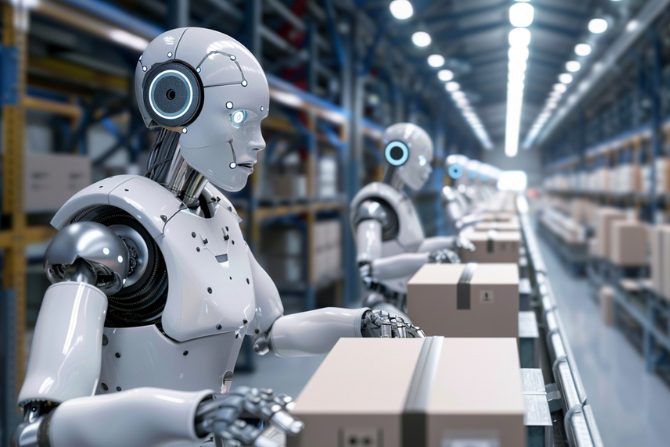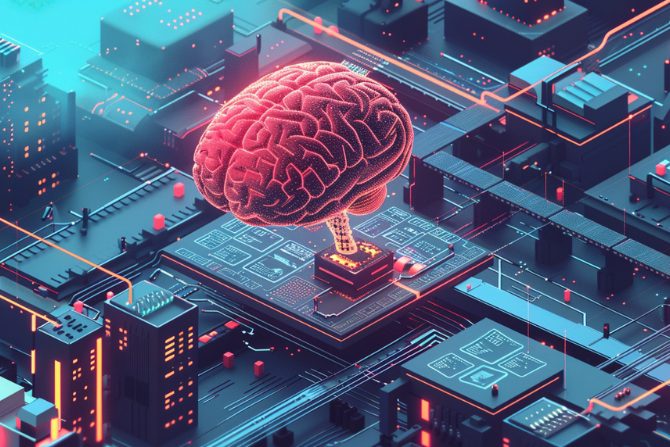
Back in 1950, Alan Turing, a British scientist and mathematician proposed the Imitation Game, a test that could determine if machines could possess the same(if not more)intelligence that we humans do. This was what you could call the earliest introduction of AI to the world, but it was on November 30, 2022, that we got a taste of the real powers of AI through ChatGPT, forcing us to answer the big question. Is this the end of the human workforce?
Supply chain management is not immune to the evolving changes in technology, especially when we talk about AI. The COVID-19 pandemic caused a domino effect of disruptions throughout global supply chains, resulting in labor shortages, shifting demands, and port congestion. But amidst the chaos, a better solution emerged: AI. With its ability to analyze vast amounts of data and make lightning-fast decisions, AI has the potential to revolutionize supply chain operations. A 2022 McKinsey survey even suggests that AI could deliver the highest cost savings within this very sector. So, is AI the grim reaper of jobs, or a powerful tool waiting to be wielded? Let’s find out the answers!
Table of Contents:
- The Benefits of AI in Supply Chain Management
- Real-World Examples of AI in Supply Chain Operations
- Overcoming Challenges in Implementing AI for Supply Chain Management
- The Future of AI-Driven Supply Chain Transformation
- FAQs in Relation to Ai in Supply Chain Management
- Conclusion
The Benefits of AI in Supply Chain Management
AI is a game-changer for supply chain management. From improving efficiency and reducing costs to enhancing demand forecasting and optimizing inventory management, AI is transforming supply chains across industries.

AI enhances supply chain efficiency and cost management.
Improved Efficiency and Cost Reduction
AI can significantly improve efficiency and reduce costs in supply chain management by automating processes, optimizing routes, and minimizing waste. According to a study by McKinsey, AI-enabled supply chain management can lead to a 15% reduction in logistics costs and a 30% increase in inventory turns.
AI algorithms can analyze vast amounts of data to identify inefficiencies, predict demand, and optimize resource allocation, resulting in streamlined operations and cost savings.
AI-powered demand forecasting enables businesses to accurately predict future demand, allowing them to optimize inventory levels and avoid stockouts or overstocking.
By analyzing historical data, market trends, and external factors, AI algorithms can generate precise demand forecasts, enabling companies to make informed decisions about production, procurement, and distribution.
This leads to improved customer satisfaction, reduced waste, and increased profitability.
Optimized Inventory Management
Anyone who’s ever faced an empty pantry or a frustrating “out-of-stock” message knows the pain of poor inventory management. But for businesses, it’s a constant tightrope walk. Holding too little stock can lead to lost sales and unhappy customers. On the other hand, cramming shelves with excess inventory ties up valuable cash and space.
AI analyzes past sales data, along with seasonal trends and even social media chatter, to predict future demand with surprising accuracy. This means businesses can order the exact amount of stock they need, at the precise moment. It can also unearth patterns in customer behavior, predicting which products are likely to be purchased together. This allows for smarter inventory allocation, guaranteeing that frequently bought items are always readily available.
By optimizing inventory levels, AI frees up valuable resources – cash, space, and even employee time – allowing businesses to focus on what they do best: serving their customers.
Proactive Risk Mitigation
AI can help businesses proactively identify and mitigate supply chain risks by continuously monitoring data from various sources, such as weather forecasts, news feeds, and social media.
AI algorithms can detect potential disruptions, such as natural disasters, political instability, or supplier failures, and provide early warnings to supply chain managers.
This allows companies to take proactive measures, such as sourcing from alternative suppliers, adjusting production schedules, or rerouting shipments, to minimize the impact of disruptions and ensure business continuity.
Real-World Examples of AI in Supply Chain Operations
AI is not just a theoretical concept. Businesses from all sorts of fields are already hopping on the bandwagon, using it to give their supply chain operations a complete makeover.
Take Amazon, for example. Their “SCOT” system uses massive datasets and deep learning to forecast demand for millions of products. This lets them stock the right items, in the right quantities, at the right warehouses around the world. AI even helps manage their army of warehouse robots! The second a customer clicks “buy,” robots are dispatched to retrieve items. Once packaged, another AI-powered system called “Robin” helps sort packages for delivery.
Let’s find out more industry giants that are implementing AI in their operations.
Intelligent Logistics Optimization
UPS, the global shipping and logistics company, has been leveraging AI to optimize its delivery routes and improve efficiency.
UPS’s AI-powered ORION (On-Road Integrated Optimization and Navigation) system analyzes data from various sources, including package delivery information, driver logs, and traffic patterns, to create the most efficient delivery routes.
This has resulted in significant cost savings, reduced fuel consumption, and improved delivery times for UPS.
Siemens, the powerhouse from Germany, has stepped up its game by integrating AI-driven predictive maintenance into its production lines.
By analyzing data from sensors embedded in machinery, AI algorithms can detect anomalies and predict potential equipment failures before they occur.
By getting ahead of the game with planned maintenance, Siemens cuts down on unexpected stops and boosts how well their equipment runs. Predictive maintenance has helped Siemens minimize production disruptions and optimize resource utilization.
AI-Powered Supplier Relationship Management
Unilever, the giant in consumer goods, is now leaning into AI to make its connections with suppliers smoother and stronger.
The company’s AI-powered platform analyzes supplier performance data, such as delivery reliability, quality metrics, and sustainability practices, to identify top-performing suppliers and areas for improvement.
This has enabled Unilever to make informed decisions about supplier selection, contract negotiations, and performance management, leading to improved supply chain resilience and reduced risks.
Overcoming Challenges in Implementing AI for Supply Chain Management
There’s a disconnect between the buzz surrounding AI and the reality of its adoption in supply chains. While a recent analysis showed nearly half of major corporations discussed AI in earnings calls, a separate survey revealed only 4.4% of businesses actually use it. So, what’s the hold-up?
One key challenge is data. AI needs high-quality, comprehensive data to function effectively. Unfortunately, supply chains often have fragmented data scattered across different systems. This makes it difficult for AI to access and analyze the complete picture, hindering its ability to make accurate predictions or decisions.
Another hurdle is expertise. Implementing and maintaining AI systems requires specialized skills in data science, engineering, and understanding both AI and supply chain operations. Many businesses simply lack the necessary in-house talent to manage AI projects effectively.
Let’s discuss these in detail:

AI can boost supply chain operations but faces integration and data quality challenges.
Talent and Skill Gap
There’s a disconnect between AI’s exciting potential and the reality of using it in supply chain management. While a whopping 93% of US and UK organizations view AI as a strategic priority, over half (51%) confess they lack the right talent to make it work. Here’s why this “talent gap” matters:
Implementing AI in supply chains requires a rare breed of professionals. They need to be fluent in the complexities of supply chain management, from forecasting demand to optimizing inventory. They also need technical expertise in AI and understand how to train and utilize AI models effectively.
Companies need to invest in training and upskilling their existing workforce, as well as attracting and retaining AI talent. This may involve partnering with educational institutions, offering internships and apprenticeships, and creating a culture of continuous learning and innovation within the organization.
Scaling AI solutions across the supply chain can be challenging, especially for large and complex supply networks. Companies need to ensure that their IT infrastructure can support the processing and storage of large volumes of data, as well as the deployment of AI models across multiple nodes in the supply chain.
This may require investments in cloud computing, edge computing, and high-performance computing resources. Additionally, companies need to establish robust data pipelines and API integrations to enable seamless data flow and interoperability between different systems and applications.
Ensuring Seamless Integration with Existing Systems
Integrating AI solutions with existing supply chain systems and processes can be a significant challenge. Companies often have legacy systems and established workflows that may not be compatible with AI technologies.
It is essential to conduct a thorough assessment of the current IT landscape and identify potential integration points and dependencies.
This may involve developing custom APIs, adapters, and middleware to enable seamless data exchange and process orchestration between AI solutions and existing systems, such as ERP, WMS, and TMS.
The Future of AI-Driven Supply Chain Transformation
The future of AI in the supply chain is not limited to friendly robots and demand forecasting but is expected to surpass technology as we know it. Here are some of the up-and-coming technologies being implemented:
1) Hyper-Personalization
Gone are the days of generic marketing and inaccurate inventory levels. AI will analyze vast amounts of customer data, buying habits, and even social media trends. This allows businesses to anticipate customer needs with incredible accuracy.
2) Collaborative Intelligence
The future workplace in supply chains won’t be a competition between humans and machines. Instead, AI-powered robots and machines will collaborate and learn alongside human workers. Production lines will become self-optimizing, automatically adjusting to real-time data on factors like resource availability and production bottlenecks.
3) End-to-End Visibility
AI will enable real-time monitoring of every step in the process, providing complete transparency. This allows for instant identification and mitigation of potential disruptions, from weather events impacting deliveries to unexpected equipment failures. AI can analyze data and suggest alternative routes or preventative maintenance schedules, minimizing delays and ensuring a more resilient supply chain.
4) The Rise of the “Human-AI Partnership”
While automation will undoubtedly increase, AI isn’t designed to replace human workers. The future of supply chains lies in a strong human-AI partnership. Humans will utilize AI’s analytical power for strategic decision-making and data-driven insights. AI, in turn, benefits from human intuition, creativity, and problem-solving skills that are crucial for handling unforeseen situations. It’s a collaborative approach, not a takeover!

AI is set to dramatically reshape supply chain management with advanced technologies enhancing decision-making and operational efficiency.
Increased Adoption Across Industries
As the benefits of AI in supply chain management become more widely recognized, we can expect to see increased adoption across various industries.
From manufacturing and retail to healthcare and agriculture, AI-driven supply chain solutions will become more prevalent, enabling organizations to optimize their operations, reduce costs, and improve customer service.
This widespread adoption will also drive the development of industry-specific AI solutions and best practices, tailored to the unique challenges and requirements of each sector.
The future of AI in supply chain management holds the potential for end-to-end automation, where AI algorithms can autonomously manage and optimize the entire supply chain process, from demand forecasting and procurement to production, logistics, and customer service.
This level of automation will require the seamless integration of AI with robotic process automation (RPA), autonomous vehicles, and smart factories, creating a fully connected and self-optimizing supply chain ecosystem.
While we might not see fully automated systems taking over supply chains anytime soon, every small step forward is making things more efficient and saving companies a good chunk of change.
Fostering a Culture of Innovation and Continuous Improvement
If companies want to tap into the full power of AI for managing their supply chains, they should really get behind a culture that loves fresh ideas and is always looking to get better.
This involves encouraging experimentation, risk-taking, and learning from failures, as well as promoting collaboration and knowledge sharing across functions and teams.
Let “good enough” become a thing of the past. Cultivate a culture where continuous improvement is the norm. Encourage employees to constantly seek ways to optimize processes and identify new opportunities for AI to enhance efficiency and performance.
By cultivating a mindset of continuous improvement and embracing AI as a strategic enabler, organizations can position themselves for long-term success in the era of AI-driven supply chain transformation.
✐ Key Takeaway:
AI is revolutionizing supply chain management by making operations more efficient, cutting costs, and boosting demand forecasting. Real-world examples like Amazon’s AI-powered warehouses show it’s not just theory but a game-changer in practice. Yet, integrating AI comes with challenges such as data quality and the need for skilled talent.
FAQs in Relation to AI in Supply Chain Management
Will AI replace humans in supply chain management?
Not immediately, but some positions and automated tasks will be replaced. AI is here to make supply chain tasks quicker and smarter offering new qualified jobs.
What are the problems with AI in supply chain?
Main hitches include data quality issues, high costs for setup, and finding folks skilled enough to run the tech.
Does Amazon use AI in supply chain?
Absolutely. Amazon leverages AI for forecasting demand, optimizing warehouses, and speeding up deliveries, as we mentioned previously in the blog.
How to use Generative AI in supply chain?
To tap into generative AI: start by automating mundane tasks. Then move on to improving decision-making with predictive analytics.
Conclusion
So, as you might’ve deduced the answer to your question, AI is not here to take over human workforce, but to make our lives easier. Think less waiting time for your orders and lower prices on goods because companies can cut down on waste.
From optimizing routes so that deliveries happen quicker than ever before to predicting what products will be hot next season, AI doesn’t replace humans; it empowers them to make better decisions quickly. As we’ve seen today, its impact ranges from tangible improvements like increased inventory turns by 30% all the way to enriching customer experiences without most realizing that there’s sophisticated tech at play here.
This silent partner in global commerce might not get all the glory or headlines Hollywood reserves for doomsday scenarios but rest assured – from warehouses buzzing with optimized operations thanks mainly due to intelligent algorithms processing vast amounts of data day in and out – Artificial Intelligence is truly transforming how we manage supplies worldwide.


